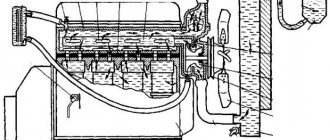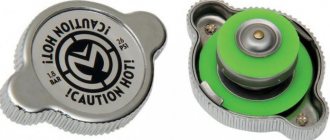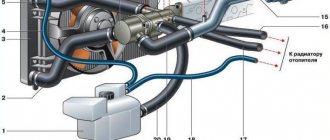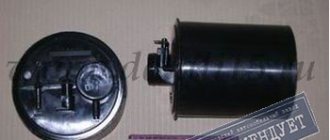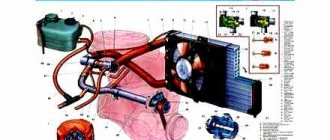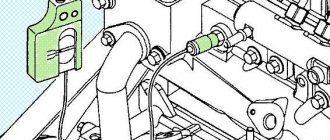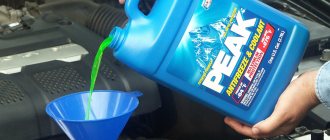Why do you need antifreeze in a car?
From the name it is clear that the main task of the liquid is to cool. What exactly does the coolant have to be cooled and why?
During engine operation, a huge amount of heat is released, especially during the compression stroke, when the temperature in the cylinders reaches 2500°; without cooling, the engine would become hot in a few minutes and fail. Antifreeze also maintains the engine operating temperature, at which the highest efficiency and economy of the internal combustion engine is achieved. The “cooler” has a second advantage - it provides the car’s interior with heat when the heater is turned on, due to the circulation of the cooling system through the heating. So, antifreeze:
- cools;
- maintains optimal engine temperature;
- protects against overheating.
The principle of operation of the coolant is simple: the engine has channels called a cooling jacket. When the operating temperature is reached, the thermostat opens and the water pump supplies fluid under pressure to the engine, after which it heats up and passes through the radiator, and again enters the internal combustion engine already cooled. In addition to its main function, antifreeze provides anti-corrosion properties, eliminates the formation of scale, and has lubricating properties that are necessary for high-quality and long-term operation of the thermostat and pump.
Video - How to replace antifreeze on a VAZ 2114
Before you start replacing antifreeze, it is worth recalling that it is quite toxic and its contact with open areas of the body, and even more so in the eyes and mouth, will lead to unpleasant consequences. In addition, it is recommended to replace antifreeze on a cold engine, since when it comes into contact with hot engine elements, it emits a characteristic odor, which has a very bad effect on human health. Thus, it is necessary to let the engine cool down and only then proceed with replacing the coolant.
Procedure:
1. Place the car on the pit, put it in first gear and exclude the possibility of any movement. Disconnect the battery terminal and turn the interior heating valve to hot air (that is, open the valve completely). Don't forget to unscrew the cap of the expansion tank.
2. Unscrew the bolts securing the engine crankcase protection and remove it.
3. Place an empty container of sufficiently large volume under the radiator drain plug. Unscrew the cap and wait until all the antifreeze has poured into the container. You should wait at least 10 minutes and try to ensure that the drops do not fall on the generator or its belt.
4. As soon as all the antifreeze has been drained, move the container under the drain hole in the cylinder block and unscrew the special bolt. To prevent antifreeze from getting on the ignition module, you can place some kind of plate. Wait until all the antifreeze has drained into the container, tighten the bolt on the engine and the cap on the radiator, and then you can start filling in new coolant.
5. This step should only be performed by those who are planning to exchange one brand of antifreeze for another brand of antifreeze. To do this, you must first flush the cooling system. To do this, fill the expansion tank with water or a special washing liquid. Close all covers and start the engine. After five minutes of operation, turn off the engine and let it cool. Drain the water or flushing fluid and tighten the drain plugs. After this procedure, you can fill in antifreeze of any other brand.
6. Fill the expansion tank with coolant to a level between o and “min”, screw on the tank cap and let the engine run for a while. After this, add antifreeze again to the required level and close the lid.
This completes the replacement of antifreeze. Good luck on the roads!
Types and differences of coolants
Today there are three types of coolant, each of which differs in characteristics, color, service life and composition:
- G11 is a traditional antifreeze that is widely used in domestic cars, as well as foreign cars, where the engine is designed for low loads and its operating temperature barely exceeds 90 degrees. G11 contains silicates and other substances in the form of inorganic additives. Their peculiarity is that such antifreeze provides a dense film on the surface of the cooling parts, protecting against corrosion. If the coolant is not replaced in a timely manner, the film loses its properties and turns into sediment, which reduces the throughput of the system, clogging the channels. It is recommended to change the coolant every 2 years or every 70,000 km; the same regulations apply to the “TOSOL” brand, which has similar properties;
- G12 is the name of the coolant, which is produced using organic acid (carboxylic acid) technology. This antifreeze has better thermal conductivity, but does not provide a protective film like G11. Here, corrosion inhibitors work pointwise; when corrosion occurs, they are directed to the foci, preventing the spread of rust. Over time, the cooling and anti-corrosion properties are lost, and accordingly the liquid changes color, so the regulations for the use of G12 are set for no more than 5 years or 25,00,000 km. The regulation also applies to hydride antifreeze (G12)+ and carboxylate (G12++);
- G13 is the latest generation in the world of coolants, referred to as lobrid. It differs from other brands of antifreeze in that the composition is based on propylene glycol (others have ethylene glycol). This means that G13 is more environmentally friendly and of higher quality. The main advantages of such a liquid are its ability to maintain the operating temperature of highly loaded modern engines, while the service life varies from 5 to 10 years, and is even considered “eternal” - for the entire service life.


